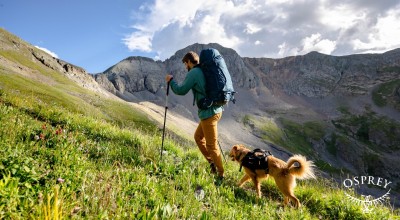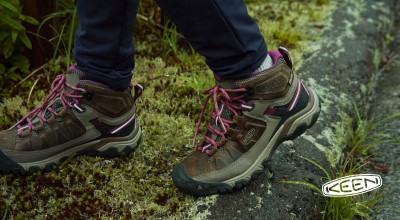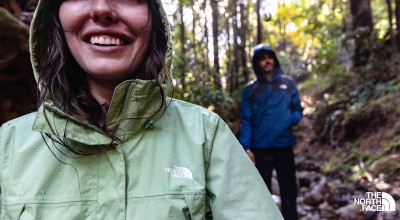What to Wear Hiking: A Checklist & Layering Tips

Like all outdoor hobbies, wearing the right clothing can make or break your hike. Whether it’s wicking away moisture, maximizing mobility, or protecting you from the elements, what you wear when hiking matters. But, no two hikes will be exactly alike. You have to consider how the terrain, temperature, season, and distance impact what you wear on your hike. To help you understand the basics of hiking clothing, our Experts share a basic hiking clothing checklist, fabrics and technology to consider, and layering suggestions to help you make the most of your time on the trails.
Basic Hiking Clothing & Gear Checklist
Many people want to know the basics of what to wear and what not to wear hiking. Here are the basic pieces of hiking clothing that our Experts suggest to start your shopping.

✔ Abrasion-resistant bottoms: You can choose to wear shorts or pants depending on the temperature, but just be sure that they are made from durable materials for added protection from branches.
✔ Moisture-wicking top: Whether it be a short-sleeve or long-sleeve top, be sure your first layer is designed to wick away moisture.
✔ High hiking socks: Wearing hiking-specific socks is important for the added cushion and materials.
✔ Hiking footwear: When it comes to hiking footwear, there are plenty of options to choose from—boots, shoes, or trail runners. What’s important is that your choice provides protection, traction, and comfort for you.
✔ Rain jacket: No matter the season, packing a waterproof/breathable rain jacket is a must because the weather can be unpredictable and change quickly!
- Featured Expert Content: How to Choose a Rain Jacket >
✔ Fleece or softshell jacket: Perhaps if you’re hiking in the heat, you can forgo this layer, but an insulating layer is another basic layer for hiking.
✔ Hat: When hiking, you want to keep your face protected from the sun’s rays.
✔ Hiking Pack: You need a place to store all your hiking layers, so be sure to find a properly-fitting hiking pack!
Hiking Clothing Fabric & Technology

You can wear anything when hiking, right? Not exactly—clothing specifically designed for hiking is made to enhance your comfort and performance while on the trails. Fabrics like Merino wool, polyester, and nylon are popular choices due to their moisture-wicking, quick-drying, and durability properties. Technologies such as GORE-TEX provide waterproofing, while UPF fabric offers sun protection. It’s also important to keep sustainability in mind when choosing hiking clothing and footwear. Many outdoor brands like KEEN, Cotopaxi, and KUHL focus on offering sustainable products so we can continue to enjoy the outdoors!
Hiking Layering Basics
When putting together your hiking outfit, layering is key no matter the season or temperature. There are three main layers to consider: base layers, mid-layer, and outer layers. Our Experts offer the basic purposes for each layer.
double breasted cropped tweed jacket | Layer #1: The Base Layer
Most people hear the term base layer and immediately think of cold weather, but a base layer means the layer that’s directly in contact with your skin. The purpose of a base layer when hiking is to wick away sweat so that you stay dry and comfortable.
In warm weather, a base layer will help you stay cool, and in cold temperatures, you’ll stay warmer.
Here’s what to pick out for your first layer:
- Underwear: Don’t skimp here. When on the trails for an extended time, you want a comfortable pair of underwear that won’t chafe and pull moisture away.
- Sports Bra: Nearly all sports bras are designed with comfortable fabrics and chafe-free seams, just be sure to find the right support level and fit.
- Socks: Wear hiking socks made from Merino wool, whether it’s a pair of Smartwool or Darn Tough socks. There are a few other considerations to make when choosing a pair of hiking socks including height, weight, cushion level, and fit.
- Tights: If you’re hiking in the winter or on a chilly day, Stradivarius poplin shirt in tie-dye will be your first layer. It’s very important to wear these under your hiking pants for additional insulation.
- Pants or Shorts: It’s up to personal preferences and temperature whether you choose to wear pants or shorts. Moto leather jacket KUHL. These pants are designed with convenient pockets for storage, rugged fabric for protection from scraps, and a slight amount of stretch for mobility.
- Short or Long-Sleeve Shirt: For a warm day, choose a shirt that wicks away sweat but also provides UPF sun protection. Colder temperatures call for a long-sleeved base layer to keep you dry and warm.
Layer #2: The Mid-Layer
The purpose of a mid-layer is to provide warmth. If you’re trekking desert trails or in the summer, you may be able to forgo this layer, but for safety, it’s not a bad idea to pack a warmer layer in your pack. For those planning on hiking in winter weather conditions, you may choose to mix and match a few different mid-layers.
Related Content: Nike Kevin Durant T-Shirts >
Here’s what to pick out for your mid-layer:
- Fleece or softshell jacket
- Lightweight jacket: Look for products that call out the jacket packs into its pocket. This will save space in your pack.
- Vest: A vest is a great alternative if you want to keep your core warm but don’t have enough room for a down jacket.
Layer #3: The Outer Layer
The purpose of the outer layer is to protect you from the elements—wind, rain, and snow.
- Rain jacket or shell: When choosing an outer layer for protection, prioritize waterproof/breathable technology and windproof protection so that you stay dry, warm, and comfortable when outdoors.
- Rain pants: For total protection from wet, rainy weather, pack a pair of rain pants to pull over your other layers when needed.
More rainy weather layering tips: What to Wear in Rainy Weather >
As you plan your next hiking adventure, keep in mind that wearing proper hiking clothing is important for comfort and protection. Layering is key when preparing hiking outfits. If you have additional questions about what to wear hiking, stop into your local ERLEBNISWELT-FLIEGENFISCHEN to speak with an Expert.


